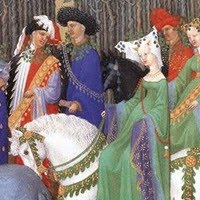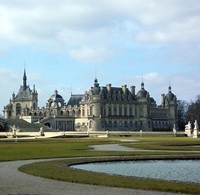|

Month of May - Detail from
Les Tres Riches Heures
By the Limbourg Brothers.
FRANCE/BELGIUM
Louvre Museum
Musee d'Orsay
Strasbourg Museum of Fine
Arts
Antwerp Museum of Fine Arts
SPAIN
Prado Museum Madrid
ITALY
Uffizi Gallery Florence
Pitti Palace, Florence
Capodimonte Museum, Naples
Vatican Museums
Sistine Chapel Frescoes
Raphael Rooms (Vatican)
Doria Pamphilj Gallery
NETHERLANDS
Mauritshuis Art Museum
Rijksmuseum Amsterdam
GERMANY - AUSTRIA - SWISS
Alte Meister Dresden
Gemaldegalerie SMPK, Berlin
Pinakothek Museum Munich
Kunsthistorisches Museum
BRITAIN
National Gallery London
British Museum
British Royal Art Collection
LEARN ART APPRECIATION
Before visiting the Musee Conde,
Chantilly, please see:
Art Evaluation: How to Appreciate Art.
|
History
Located in the historical French town of Chantilly, and about an hour's
drive from Paris, Chateau de Chantilly was built by master mason Pierre
Chambiges (d.1544) in the 16th century for Anne de Montmorency (1493-1567).
Today, it comprises of two main buildings, the Grand Chateau which was
destroyed in the French Revolution and rebuilt in the 1870s, and the Petit
Chateau which was built for de Montmorency. Now owned by the Institute
of France, the Chateau houses one of the finest art collections in France
in its gallery the Musee Conde. The gallery has a world famous collection
of medieval art, including
illuminated
manuscripts and other rare texts, along with paintings from the Renaissance
and the Baroque.
The Permanent
Collection
Many of the gallery's works are displayed in a rather haphazard manner,
in no particular chronological order or art school. Apparently the Duke
who donated the Chateau to the Institute of France in 1897 requested that
exhibits not be reorganized. Most of the important paintings can be found
in a small room called the Sanctuaire, including examples of medieval
painting by the French Renaissance artist Jean
Fouquet (1420-81) and Italian High Renaissance painter Raphael (1483-1520).
Passing through the Galerie de Psyche with its stained
glass art, the visitor next enters the Tribune Room where the
remaining important works are located including paintings by Sandro Botticelli
(1445-1510), Piero di Cosimo
(1462-1522) and Filippino
Lippi (1457-1504). Other painters represented include Fra Angelico
(1395-1455), painter and printmaker Federico
Barocci (c.1526-1612), members of the Bolognese
school such as Baroque painters Annibale
Carracci (1560-1609), Domenichino
(1581-1641), Guercino (1591-1666)
and Salvator Rosa (1615-76).
Also in the collection are works by the great French classicist Nicolas
Poussin (1594-1665), the eminent Flemish portrait artist Sir Anthony
Van Dyck (1599-1641), rococo artist Jean-Antoine
Watteau (1684-1721), portraitists Jean-Baptiste
Greuze (1725-1805), and Sir Joshua Reynolds (1723-92). It also has
French painting by
the doyen of the Paris Academy J.A.D.Ingres
(1780-1867), landscapist
Corot (1796-1875), Romantic painter Eugene
Delacroix (1798-1863), as well as the caricaturist and lithographer
Theodore Gericault
(1791-1824). The gallery also owns 366 restored portrait drawings by Jean
Clouet (1480-1541) and his son Francois (1510-72), which were originally
owned by Queen Catherine de Medici.
|
![]()
